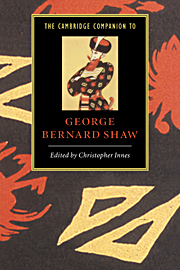Book contents
- Frontmatter
- Part 1 The social and cultural context
- Part 2 Shaw the dramatist
- 5 Shaw's early plays
- 6 Shavian comedy and the shadow of Wilde
- 7 Structure and philosophy in Man and Superman and Major Barbara
- 8 “Nothing but talk, talk, talk - Shaw talk”
- 9 The roads to Heartbreak House
- 10 Reinventing the history play
- 11 Shaw's interstices of empire
- 12 The later Shaw
- Part 3 Theatre work and influence
- Index
9 - The roads to Heartbreak House
from Part 2 - Shaw the dramatist
Published online by Cambridge University Press: 28 May 2006
- Frontmatter
- Part 1 The social and cultural context
- Part 2 Shaw the dramatist
- 5 Shaw's early plays
- 6 Shavian comedy and the shadow of Wilde
- 7 Structure and philosophy in Man and Superman and Major Barbara
- 8 “Nothing but talk, talk, talk - Shaw talk”
- 9 The roads to Heartbreak House
- 10 Reinventing the history play
- 11 Shaw's interstices of empire
- 12 The later Shaw
- Part 3 Theatre work and influence
- Index
Summary
On June 8, 1917, Bernard Shaw invited a few friends to hear him read a new play, his first full-length piece since Pygmalion, written in 1913. Four of them were people with special knowledge of the materials that had gone into Shaw's cauldron: Henry Massingham, Gilbert Murray, Sydney Olivier, and Kathleen Scott, the widow of Scott of the Antarctic. They seemed likelier than most listeners to understand what he was up to in this, his most difficult work. Some perhaps were in a better position to understand it than he was - Kathleen Scott, undoubtedly, knew better than the playwright what motives had driven her husband to try and outface death in the hardest, most dangerous place on earth. Shaw may even have hoped they might help him to understand his play better himself.
For Heartbreak House had given more trouble coming to birth than any of his previous plays. He had started to write it on March 4, 1916, but three months later still had no clear idea where it was going. "I, who once wrote plays d'un seul trait" he wrote to Mrs. Patrick Campbell on May 14, "am creeping through a new one (to prevent myself crying) at odd moments, two or three speeches at a time. I don't know what it is about." In November he read the first act to Lady Gregory, but told her he did not know how to go on, what he had written was so wild. In December he confessed to William Archer that he still had only one act, and was stuck.
- Type
- Chapter
- Information
- The Cambridge Companion to George Bernard Shaw , pp. 180 - 194Publisher: Cambridge University PressPrint publication year: 1998
- 1
- Cited by



